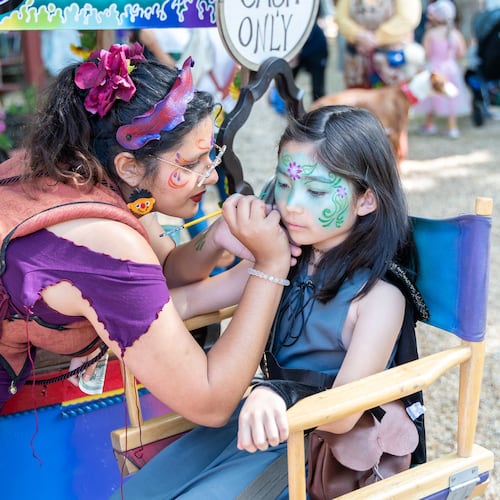Credit: Bo Emerson
Credit: Bo Emerson
Color pours down the slopes of a ridge like a flowery waterfall at the new Atlanta Botanical Garden satellite facility in Gainesville.
To drive home the point, the garden designers created a small water feature to tumble alongside the creeping phlox, so the falling water and a meandering switchback of purple and white blossoms appear to mimic each other's dance moves.
After years in development, the Atlanta Botanical Garden, Gainesville, opens to the public Saturday, revealing that the biggest Atlanta botanical garden isn't in Atlanta.
The Gainesville garden stretches across 168 acres, more than five times the size of the Atlanta space. Gainesville's facilities are equally sizable, including an outdoor amphitheater that can seat 2,000 and a 5,000-square-foot green house that is one of the largest conservation nurseries in the Southeast.
But what greets visitors to the new attraction is a compact five-acre garden, which is part of the $21 million first phase of development.
On a warm afternoon in April, Mildred Fockele, vice president of horticulture, walks through the lobby of the visitor's center. Overhead the distinctive cypress-lined ceiling rises at a steep angle, spilling pedestrians into the garden beyond, like a horn of plenty.
"The whole building becomes a threshold to the garden, " said architect Steve Robinson, "like a really nice doorway, with bathrooms."
Out on the terrace a soft breeze carries the scent of Himalayan sweet box and fragrant camellia around the property.
The quiet is accented by a bubbling shallow pond that surrounds the Adirondack chairs and wicker settees. "You really feel like you're in the woods, " says Fockele.
From the walking trail, one sees the contrast between the colorful plantings and the more restrained surrounding valleys, still turning from dun to green. A pileated woodpecker flies off sideways and interrupts the afternoon with its drunk laughter.
The feeling at the garden is indeed one of separation from the hustling world out on I-985. Though the garden is on the edge of urban Gainesville, it is buffered by trees in almost every direction.
Yet despite the distance, the garden is still part of Atlanta in several ways. It's considered another campus of the Atlanta garden, said Fockele, like the scattered campuses of the University of Georgia system. It has also taken over nursery duties for the Atlanta campus. And, as the metro area (and Gainesville itself) expands steadily, the Gainesville campus will be preserved as an island of green within the megalopolis.
The acreage was given to the garden in 2001 by Celestia "Lessie" Smithgall and her late husband Charles A. Smithgall Jr., owner of a newspaper, television and radio stations. The Smithgalls are also the benefactors who assembled a 5,500-acre tract in White County surrounding Duke's Creek that is now a heritage preserve called the Smithgall Woods.
Lessie Smithgall turned 104 on April 1, and still lives on the property, on 17 acres that will also eventually pass into the hands of the Atlanta Botanical Garden.
In addition to serving as a respite for weary urbanites, the Gainesville campus will be a refuge for many plant species in danger of disappearing.
Fockele collected some of those plants during a 1996 trip to China, rescuing plants that were in the path of a dam project. She came back with 125 different seed collections. During a tour of the greenhouses, she spoke to the garden interns tending bed after bed of plants grown from those seeds.
Computer-controlled irrigation systems keep the plants properly watered while fans whirr and motorized shades open and shut, controlling light and temperature.
Fockele inhaled from a pungent syringa pubescens (or lilac), and showed off a calocedrus macrolepis (Yunnan cypress), toad lily, hydrangea and a short, bonsai-looking tree called Suwanee Squat, a dwarf dogwood that won't grow past four feet tall.
She found the cypress growing in a graveyard behind a truck-stop off a Yunnan back road. It was one of the last examples of that species still alive. Her nursery has germinated plants from such seeds and has sent them to hundreds of botanical gardens around the country.
"It's great to see some of your children growing and thriving, " she said.
Such conservation is part of the mission of the botanical garden and is what sets it apart from a nature preserve or a park.
These nurseries also supply plants for the gardens in Atlanta and Gainesville. Out of the 1,200 specimens growing in Gainesville, 400 were germinated in the nursery.
On a larger scale, the garden's efforts serve the national Center for Plant Conservation. "We are one of 10 gardens that hold the national collection of magnolias and one of eight holding the collection of maples, " said Fockele.
There are more developments planned at the Gainesville garden. Another water feature will dip into the ravine, which drops 120 feet to a secluded cove on the shore of Lake Lanier. Designers will also plant a children's garden, sometime in the next year.
The Gainesville garden will also host a small concert series, featuring Emmy Lou Harris and Rodney Crowell June 13, The Temptations July 11 and Scotty McCreery July 17.
In the meantime, Gainesville is celebrating spring in a new way, with a new garden and new life.
EVENT PREVIEW
The Atlanta Botanical Garden, Gainesville
Grand opening 11 a.m.-3 p.m. Saturday-Sunday, May 2-3.
Live entertainment, games, crafts, face painting and more. Food and beverage available for purchase. $8 adults, $5 children 12-3, free for kids younger than 3. Summer hours: 9 a.m.-6 p.m., Tuesday-Sunday; winter hours to be determined. 1911 Sweetbay Drive, Gainesville. 404-876-5859; atlantabg.org/visit/gainesville.
At myAJC.com/sundayliving, you'll find more on the expansion at the Atlanta Botanical Garden, plus a list of concerts at the gardens in Atlanta and Gainesville.
About the Author
The Latest
Featured



